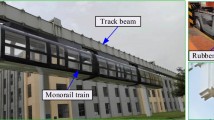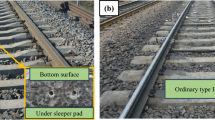Abstract
An integrated vehicle-biodynamic model is developed in this article by using multi-domain energy domain bond graph model simulation and multi-body simulation software ADAMS VI-Rail. These models are specifically used to evaluate passenger ride comfort in a railway vehicle where vertical and lateral excitations at the wheels arise out of the track irregularities. In the bond graph model, the carbody of the railway vehicle is treated as an Euler-Bernoulli beam and its first five modes are included in the model. Thereafter, a detailed model of the railway vehicle is created in ADAMS VI-Rail. The International Organization for Standardization (ISO) 2631 specification is used to determine the passenger comfort for different travel durations and track irregularities.
Similar content being viewed by others
References
H. Suzuki, Research trends on riding comfort evaluation in Japan, Proceedings of the Institution of Mechanical Engineers, Part F: Journal of Rail and Rapid Transit, 212 (1) (1998) 61–72.
M. J. Griffin, Handbook of human vibration, Academic press, London (1990) 53–71.
V. K. Garg and R. V. Dukkipati, Dynamics of railway vehicle systems, Academic Press, Canada (1984).
ISO 2631(E):1974, Guide for the evaluation of human exposure to whole-body vibration, International Organization for Standardization, Geneva (1974).
ISO 2631/1:1985, Evaluation of human exposure to wholebody vibration. Part 1. General Requirements, International Organization for Standardization (1985).
ISO/DIS 2631-1.2: 1995, Mechanical vibration and shockevaluation of human exposure to whole-body vibration. Part 1: General Requirements, International Organization for Standardization (1995).
UIC 513R, Guidelines for evaluating passenger comfort in relation to vibration in railway vehicles, International Union of Railways (1994).
ENV 12299, Railway applications-ride comfort for passengers-measurement and evaluation, European Committee for Standardization (1999).
Y. G. Kim, H. B. Kwon, S. W. Kim, C. K. Kim and T. W. Kim, Correlation of ride comfort evaluation methods for railway vehicles, Proceedings of the Institution of Mechanical Engineers, Part F: Journal of Rail and Rapid Transit, 217 (2) (2003) 73–88.
P. F. Carlbom, Combining MBS with FEM for rail vehicle dynamics analysis, Multibody System Dynamics, 6 (3) (2001) 291–300.
W. Kunpeng, X. He, X. Man and G. Weiwei, Dynamic analysis of train-bridge interaction system with flexible carbody, Journal of Mechanical Science and Technology, 29 (9) (2015) 3571–3580.
H. Shi and P. Wu, Flexible vibration analysis for car body of high-speed EMU, Journal of Mechanical Science and Technology, 30 (1) (2016) 55–66.
D. Gong, J. Zhou and W. Sun, Passive control of railway vehicle car body flexural vibration by means of underframe dampers, Journal of Mechanical Science and Technology, 31 (2) (2017) 555–564.
P. E. Boileau, S. Rakheja and X. Wu, A body mass dependent mechanical impedance model for applications in vibration seat testing, Journal of Sound and Vibration, 253 (1) (2002) 243–264.
G. Diana, F. Cheli, A. Collina, R. Corradi and S. Melzi, The development of a numerical model for railway vehicles comfort assessment through comparison with experimental measurements, Vehicle System Dynamics, 38 (3) (2002) 165–183.
J. Zhou, R. Goodall, L. Ren and H. Zhang, Influences of car body vertical flexibility on ride quality of passenger railway vehicles, Proc. ImechE Part F: Journal of Rail and Rapid Transit, 223 (5) (2009) 461–471.
M. Berg, A three-dimensional air spring model with friction and orifice damping, Vehicle System Dynamics Supplement, 33 (1999) 528–539.
A. Mukherjee, R. Karmakar and A. K. Samantaray, Bond graph in modeling, simulation and fault identification, CRC Press, FL (2006).
W. Borutzky, Bond graph methodology: Development and analysis of multidisciplinary dynamic system models, Springer Science & Business Media (2009).
A. K. Samantaray and B. Ould Bouamama, Model-based process supervision: A bond graph approach, Springer Science & Business Media (2008).
D. C. Karnopp, D. L. Margolis and R. C. Rosenberg, System dynamics: Modeling, simulation, and control of mechatronic systems, John Wiley & Sons (2012).
V. Kumar, V. Rastogi and P. M. Pathak, Modeling and simulation of rail wheel-set on irregular tangent track for stability analysis, Advances in Intelligent and Soft Computing, 131 (2011) 343–353.
N. Banerjee and R. Karmakar, Bond graph modeling of rail wheelset on curved track, Simulation, 83 (10) (2007) 695–706.
N. Banerjee, A. K. Saha and R. Karmakar, Bond graph modeling of a railway truck on curved track, Simulation Modelling Practice and Theory, 17 (1) (2009) 22–34.
V. Kumar, V. Rastogi and P. M. Pathak, Simulation for whole-body vibration to assess ride comfort of a low–medium speed railway vehicle, Simulation (2016) 0037549716679254.
A. K. Samantaray, SYMBOLS Shakti user’s manual, high tech consultants, STEP, Indian Institute of Technology, Kharagpur (2009).
R. Merzouki, A. K. Samantaray and P. M. Pathak, Intelligent mechatronic systems: Modeling, control and diagnosis, Springer Science and Business Media (2012).
J. A. Zakeri, M. Fattahi and M. M. Ghanimoghadam, Influence of unsupported and partially supported sleepers on dynamic responses of train–track interaction, Journal of Mechanical Science and Technology, 29 (6) (2015) 2289–2295.
V. R. Dukkipati and J. R. Amyot, Computer-aided simulation in railway dynamics, Marcel Dekker, NY (1988).
M. Presthus, Derivation of air spring model parameters for train simulation, M.S. Thesis, Luleå University of Technology, Sweden (2002).
L. Mazzola and M. Berg, Secondary suspension of railway vehicles-air spring modeling: Performance and critical issues, Proceedings of the Institution of Mechanical Engineers, Part F: Journal of Rail and Rapid Transit Part F: Journal of Rail and Rapid Transit, 228 (3) (2014) 225–241.
S. J. Park and M. Subramaniyam, Evaluating methods of vibration exposure and ride comfort in car, Journal of the Ergonomics Society of Korea, 32 (4) (2013) 381–387.
D. Cui, H. Wang, L. Li and X. Jin, Optimal design of wheel profiles for high-speed trains, Proceedings of the Institution of Mechanical Engineers, Part F: Journal of Rail and Rapid Transit, 229 (3) (2015) 1–14.
Author information
Authors and Affiliations
Corresponding author
Additional information
Recommended by Associate Editor Sungsoo Na
Smitirupa Pradhan received her B.E. degree in mechanical engineering from BPUT, Bhubaneswar in 2004, and M.Tech. degree in mechanical systems design from IIT Kharagpur in 2012. She taught at various engineering colleges from 2004 to 2012. She is currently pursuing Ph.D. at IIT Kharagpur. Her research interests are modeling, simulation and control of engineering systems, vehicle dynamics, and systems engineering.
Arun Kumar Samantaray received his B.Sc. (Engg.) degree in mechanical engineering from CET, Bhubaneswar in 1989, and M.Tech. and Ph.D. degrees from IIT Kharagpur in machine dynamics and rotor dynamics, respectively, in 1991 and 1996. He did post-doctoral research at Polytech’ Lille from 2001 to 2004. Currently, he is a Full Professor at IIT Kharagpur. His research interests are systems and control, vehicle dynamics, robotics, and non-linear mechanics.
Rights and permissions
About this article
Cite this article
Pradhan, S., Samantaray, A.K. Integrated modeling and simulation of vehicle and human multi-body dynamics for comfort assessment in railway vehicles. J Mech Sci Technol 32, 109–119 (2018). https://doi.org/10.1007/s12206-017-1212-z
Received:
Revised:
Accepted:
Published:
Issue Date:
DOI: https://doi.org/10.1007/s12206-017-1212-z




